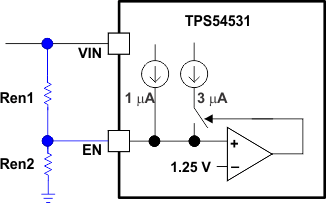ZHCSB15B May 2013 – October 2023 TPS54531
PRODUCTION DATA
- 1
- 1 特性
- 2 应用
- 3 说明
- 4 Revision History
- 5 Pin Configuration and Functions
- 6 Specifications
-
7 Detailed Description
- 7.1 Overview
- 7.2 Functional Block Diagram
- 7.3
Feature Description
- 7.3.1 Fixed-Frequency PWM Control
- 7.3.2 Voltage Reference (Vref)
- 7.3.3 Bootstrap Voltage (BOOT)
- 7.3.4 Enable and Adjustable Input Undervoltage Lockout (VIN UVLO)
- 7.3.5 Programmable Slow Start Using SS Pin
- 7.3.6 Error Amplifier
- 7.3.7 Slope Compensation
- 7.3.8 Current-Mode Compensation Design
- 7.3.9 Overcurrent Protection and Frequency Shift
- 7.3.10 Overvoltage Transient Protection
- 7.3.11 Thermal Shutdown
- 7.4 Device Functional Modes
-
8 Application and Implementation
- 8.1 Application Information
- 8.2
Typical Application
- 8.2.1 Design Requirements
- 8.2.2
Detailed Design Procedure
- 8.2.2.1 Custom Design With WEBENCH® Tools
- 8.2.2.2 Switching Frequency
- 8.2.2.3 Output Voltage Set Point
- 8.2.2.4 Undervoltage Lockout Set Point
- 8.2.2.5 Input Capacitors
- 8.2.2.6 Output Filter Components
- 8.2.2.7 Compensation Components
- 8.2.2.8 Bootstrap Capacitor
- 8.2.2.9 Catch Diode
- 8.2.2.10 Slow-Start Capacitor
- 8.2.2.11 Output Voltage Limitations
- 8.2.2.12 Power Dissipation Estimate
- 8.2.3 Application Curves
- 8.3 Power Supply Recommendations
- 8.4 Layout
- 9 Device and Documentation Support
- 10Mechanical, Packaging, and Orderable Information
7.3.4 Enable and Adjustable Input Undervoltage Lockout (VIN UVLO)
The EN pin has an internal pullup current-source that provides the default condition of the TPS54531 device while operating when the EN pin floats.
The TPS54531 device is disabled when the VIN pin voltage falls below the internal VIN UVLO threshold. Using an external VIN UVLO to add at least 500-mV hysteresis is recommended unless the VIN voltage is greater than (VOUT + 2 V). To adjust the VIN UVLO with hysteresis, use the external circuitry connected to the EN pin as shown in Figure 7-1. When the EN pin voltage exceeds 1.25 V, an additional 3 μA of hysteresis is added. Use Equation 1 and Equation 2 to calculate the resistor values required for the desired VIN UVLO threshold voltages. The VSTOP must always be greater than 3.5 V.
 Figure 7-1 Adjustable Input Undervoltage Lockout
Figure 7-1 Adjustable Input Undervoltage Lockoutwhere
- VSTART is the input start threshold voltage
- VSTOP is the input stop threshold voltage
where
- VEN is the enable threshold voltage of 1.25 V
The external start and stop voltages are approximate. The actual start and stop voltages can vary.